

RESEARCH: Top Companies Organize Their Workplaces Better Than You. RESEARCH: Top Companies Organize Their Workplaces Better Than You Call me a glutton for punishment, but I like reading workplace research.

There is something divine about snuggling up on a Saturday with a cup of coffee, a cat, and a good study. But really, workplace research is actually very interesting and necessary. Which brings me to a 2008 Gensler Workplace Survey [pdf] that found four key areas where top performing companies design their workplaces more effectively than average performing companies. These companies also tend to fare better in certain important metrics. Focus | Collaboration | Learning | Socializing One of the debates I’m always bringing up is that of open vs. closed offices. Employees need time to focus, but they also need time to collaborate. Employees also need the ability to have community and socialization in the workplace to make it more meaningful. Employees should also be encouraged to learn. Better Workplace = Satisfied Employees. Workspace Design Trends To Increase Your Productivity. Creating paths for chance meetings, including nooks, and designing agile, unique workspaces are solutions that designers say promote collaboration, creativity, and productivity in the modern office.
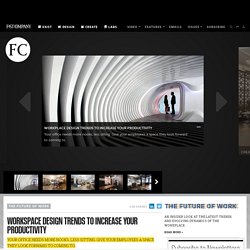
"In the last four to five years, we’ve all been focusing on sustainability and the impact technology has in an office," says Kay Sargent, director of workplace strategies at infrastructure solutions provider Lend Lease. "During this time, we’ve forgotten that we’re designing for people. Millennial Branding - Gen-Y Research & Management Consulting Firm. Millennial Branding and Randstad US Release First Worldwide Study Comparing Gen Y and Gen Z Workplace Expectations Findings reveal Gen Z is entrepreneurial, less motivated by money and more focused on face-to-face communication compared to Gen Y.

NEW YORK, September 2, 2014 – Millennial Branding, a Gen Y research and consulting firm, and Randstad, the third-largest HR services and staffing company in the United States, today announced results from the first worldwide study to focus on the workplace preferences of both Generation Y (ages 21 to 32) and Generation Z (ages 16 to 20). Key takeaways from the findings show: Gen Z has more of an entrepreneurial spirit 17% of Gen Z vs. 11% of Gen Y wants to start a business and hire others.
For Gen Z, it’s not about the money … yet Only 28% of Gen Z said money would motivate them to work harder and stay with their employer longer, as opposed to 42% of Gen Y. Entitled “Gen Y vs. The Future Of Learning Is Here! That’s right.
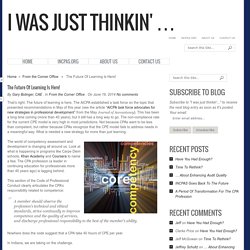
The future of learning is here. Balancing “We” and “Me”: The Best Collaborative Spaces Also Support Solitude - HBR. Artwork: Michael Wolf, The Transparent City 11, 2008 Let us know what you think of your workspace and see how you compare with others.
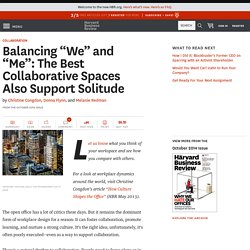
For a look at workplace dynamics around the world, visit Christine Congdon’s article “How Culture Shapes the Office” (HBR May 2013). The open office has a lot of critics these days. But it remains the dominant form of workplace design for a reason: It can foster collaboration, promote learning, and nurture a strong culture. It’s the right idea; unfortunately, it’s often poorly executed—even as a way to support collaboration.
There’s a natural rhythm to collaboration. Companies have been trying for decades to find the balance between public and private workspace that best supports collaboration. The open plan is just one of the culprits assaulting our privacy. Leaving the office to work at home or in coffee shops or libraries isn’t the answer—at least not for the long term. 21 Inspirational Collaboration Workspaces. If your company isn't thinking about collaboration and creating an office design centered around collaboration, chances are that the office you've built is stuck in the doldrums.
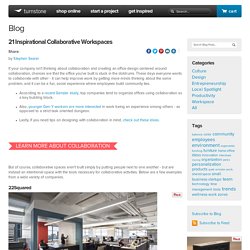
These days everyone wants to collaborate with other - it can help improve work by getting more minds thinking about the same problem, and it can be a fun, social experience where employees build community ties. According to a recent Gensler study, top companies tend to organize offices using collaboration as a key building block. But of course, collaborative spaces aren't built simply by putting people next to one another - but are instead an intentional space with the tools necessary for collaborative activities. Below are a few examples from a wide variety of companies. Contrasting Generation Y and Z The numbers are in from recent studies of younger teens of Generation Z, also known as "Homelanders" or the kids who follow Generation Y.

They are part of a population who grew up during the aftermath of 9/11, where terrorism is part of the landscape, a sour economy is all they know and uncertainty defines our mindsets. Office Design Case Study: How Cisco Designed the Collaborative Connected Workplace Environment - Cisco on Cisco. In This Case Study PDF Version Cisco Systems® employees work differently than they did as recently as a few years ago.
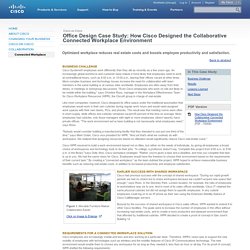
An increasingly global workforce and customer base makes it more likely that employees need to work at nontraditional hours, such as 6:00 a.m. or 10:00 p.m., leaving their offices vacant at other times. More complex business and technology issues increase the need for collaboration with team members in the same building or at various sites worldwide. Employees are often away from their desks, in meetings or workgroup discussions. Like most companies, however, Cisco designed its office space under the traditional assumption that employees would work in their own cubicles during regular work hours and would need assigned work spaces with their own desks, PCs, and phones. "Nobody would consider building a manufacturing facility that they intended to use just one-third of the time," says Mark Golan, Cisco vice president for WPR. Encouraging collaboration. Figure 2. Planning.